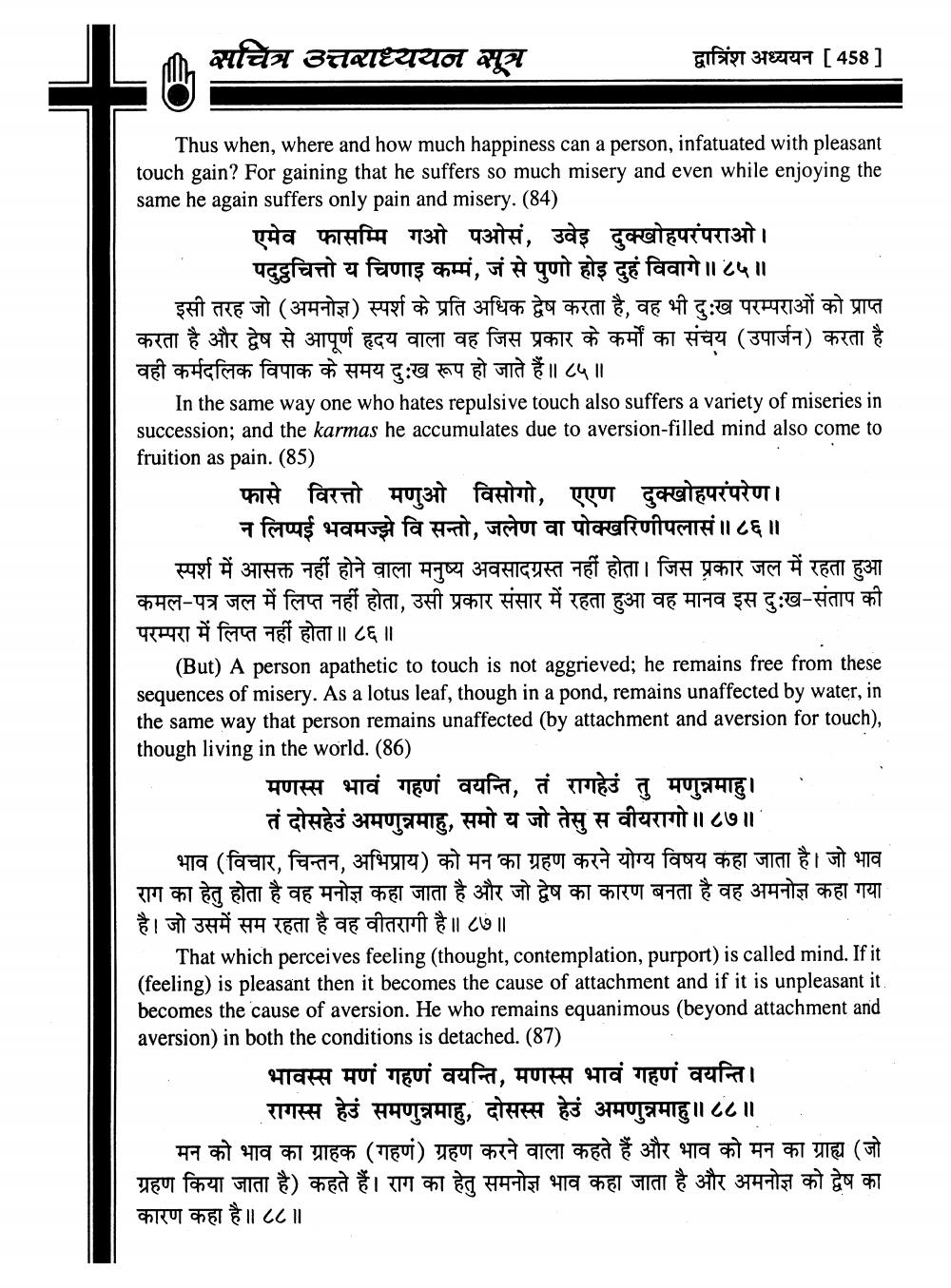________________
सचित्र उत्तराध्ययन सूत्र
द्वात्रिंश अध्ययन [ 458]
Thus when, where and how much happiness can a person, infatuated with pleasant touch gain? For gaining that he suffers so much misery and even while enjoying the same he again suffers only pain and misery. (84)
एमेव फासम्म गओ पओसं, उवेइ दुक्खोहपरंपराओ । चित्तोय चिणाइ कम्मं, जं से पुणो होइ दुहं विवागे ॥ ८५ ॥
इसी तरह जो ( अमनोज्ञ) स्पर्श के प्रति अधिक द्वेष करता है, वह भी दुःख परम्पराओं को प्राप्त करता है और द्वेष से आपूर्ण हृदय वाला वह जिस प्रकार के कर्मों का संचय ( उपार्जन) करता है वही कर्मदलिक विपाक के समय दुःख रूप हो जाते हैं ॥ ८५ ॥
In the same way one who hates repulsive touch also suffers a variety of miseries in succession; and the karmas he accumulates due to aversion-filled mind also come to fruition as pain. (85)
फासे विरत्तो मणुओ विसोगो, एएण दुक्खोहपरंपरेण । न लिप्पई भवमज्झे वि सन्तो, जलेण वा पोक्खरिणीपलासं ॥ ८६ ॥
स्पर्श में आसक्त नहीं होने वाला मनुष्य अवसादग्रस्त नहीं होता । जिस प्रकार जल में रहता हुआ कमल-पत्र जल में लिप्त नहीं होता, उसी प्रकार संसार में रहता हुआ वह मानव इस दुःख - संताप की परम्परा में लिप्त नहीं होता ॥ ८६ ॥
(But) A person apathetic to touch is not aggrieved; he remains free from these sequences of misery. As a lotus leaf, though in a pond, remains unaffected by water, in the same way that person remains unaffected (by attachment and aversion for touch), though living in the world. (86)
मणस्स भावं गहणं वयन्ति तं रागहेडं तु मणुन्नमाहु | तं दोसउं अमणुन्नमाहु, समो य जो तेसु स वीयरागो ॥ ८७ ॥
भाव (विचार, चिन्तन, अभिप्राय) को मन का ग्रहण करने योग्य विषय कहा जाता है। जो भाव राग का हेतु होता है वह मनोज्ञ कहा जाता है और जो द्वेष का कारण बनता है वह अमनोज्ञ कहा गया है। जो उसमें सम रहता है वह वीतरागी है ॥ ८७ ॥
That which perceives feeling (thought, contemplation, purport) is called mind. If it (feeling) is pleasant then it becomes the cause of attachment and if it is unpleasant it. becomes the cause of aversion. He who remains equanimous (beyond attachment and aversion) in both the conditions is detached. (87)
भावस्स मणं गहणं वयन्ति, मणस्स भावं गहणं वयन्ति । रागस्स हेउं समणुन्नमाहु, दोसस्स हेउं अमणुन्नमाहु ॥ ८८ ॥
मन को भाव का ग्राहक (गहणं ) ग्रहण करने वाला कहते हैं और भाव को मन का ग्राह्य (जो ग्रहण किया जाता है) कहते हैं। राग का हेतु समनोज्ञ भाव कहा जाता है और अमनोज्ञ को द्वेष का कारण कहा है॥ ८८ ॥




